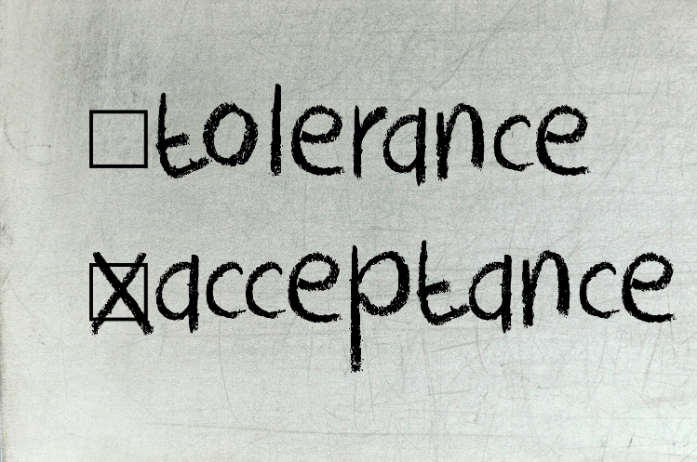I was working with a leadership development group on the topic of conflict (one of my favorites, since I grew up in a family that didn’t have conflict HAHAHA). Rarely do I use another person’s slides, but that’s how this one worked out.
I put up a slide—which I’d missed seeing somehow—that suggested we “develop a tolerance for others’ beliefs and norms.” My first thought was “How the *&$# did I miss this awful slide?” I was immediately glad I did miss it. Words are important. The class took a turn into what I always hope for—chaos, our greatest ally for learning. Some of them were offended by the word tolerance, some couldn’t understand what was wrong.
Tolerance is one of those words we throw around, like empowerment, another of my least-favorite buzzwords. Empower is a transitive verb, which means we do it to people. When I brag about empowering my employees or my students (or my children), I’m highlighting my own power: If I DO IT to them, who really has the power? I direct the folks I coach to reframe the idea as power sharing, which you don’t do to people but with people. When we speak differently, we think differently.
…we need to be better at tolerating each other’s differences.
The root meaning of tolerance is a person’s ability to bear pain. So if I proudly proclaim how tolerant I am, I’m citing my ability to bear the pain of others’ differences. I heard a politician talking about England’s decision to leave the EU, and he suggested “we need to be better at tolerating each other’s differences.” Ouch. I don’t think he even considered what he was saying.
Tolerance is condescending. It’s most often touted by the dominant group within a culture, organization, or bureaucracy (like school systems), seldom by those on the receiving end of the you’re different stick. We only need to tolerate differences if those differences cause us pain. Why should any teacher, supervisor, or trainer ever think that tolerance is anything but divisive? Being on the receiving end of pale tolerance is downlifting (the opposite of uplifting).
Let those of us with apparent power, especially when we’re responsible for leading others, start to embrace, and practice, acceptance. I’m a recovering English teacher, so words fascinate me enough to really pay attention. Acceptance evolved from words meaning to receive willingly. How much more powerful and inclusive is that than pale tolerance? I tolerate your difference, I accept our difference. Which position promotes better understanding?
After a time, when we grow comfortable with acceptance and see how much better we start to learn from others and they from us, we can progress tocelebrating our differences. And that word’s deepest meaning is assemble to honor.
What if our workplaces celebrated our differences? What if schools moved from the industrial/assembly line tolerance of difference to a celebration? I listen to students all the time, and they feel the condescension of pale tolerance from their teachers and administrators, as do the people I coach in the adult work place.
When we start changing the language we use, our understanding will follow. Acceptance and celebration are for people. Tolerance is for injuries.
BTW, the class agreed to change the slide to acceptance. It was a turning point and well worth the chaos that got us there.
Mac Bogert is the founder of AZA Learning, which provides leadership coaching and learning-design support to 200 clients nationwide. His latest publication is “Learning Chaos: How Disorder Can Save Education.” The book explores the disconnect between what schools do and how people learn. In it, Bogert suggests concrete steps to remove barriers to learning in schools and training centers.
Become a Harlem Insider!
By submitting this form, you are consenting to receive marketing emails from: . You can revoke your consent to receive emails at any time by using the SafeUnsubscribe® link, found at the bottom of every email. Emails are serviced by Constant Contact









